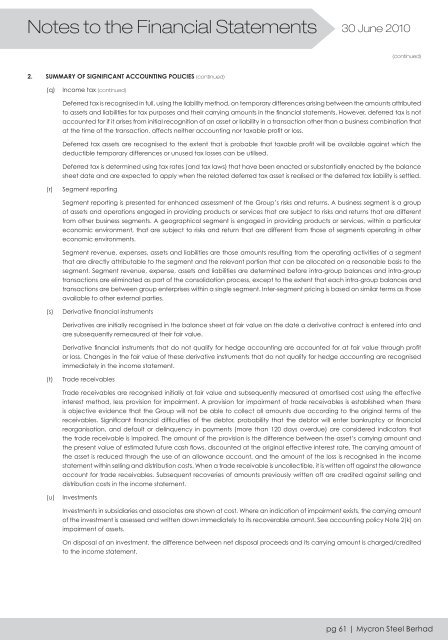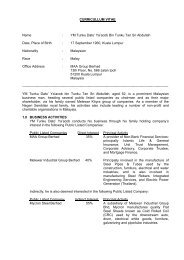Annual Report (Complete) - MYCRON Steel Berhad
Annual Report (Complete) - MYCRON Steel Berhad
Annual Report (Complete) - MYCRON Steel Berhad
Create successful ePaper yourself
Turn your PDF publications into a flip-book with our unique Google optimized e-Paper software.
Notes to the Financial Statements<br />
30 June 2010<br />
(continued)<br />
2. SUMMARY OF SIGNIFICANT ACCOUNTING POLICIES (continued)<br />
(q)<br />
Income tax (continued)<br />
Deferred tax is recognised in full, using the liability method, on temporary differences arising between the amounts attributed<br />
to assets and liabilities for tax purposes and their carrying amounts in the financial statements. However, deferred tax is not<br />
accounted for if it arises from initial recognition of an asset or liability in a transaction other than a business combination that<br />
at the time of the transaction, affects neither accounting nor taxable profit or loss.<br />
Deferred tax assets are recognised to the extent that is probable that taxable profit will be available against which the<br />
deductible temporary differences or unused tax losses can be utilised.<br />
Deferred tax is determined using tax rates (and tax laws) that have been enacted or substantially enacted by the balance<br />
sheet date and are expected to apply when the related deferred tax asset is realised or the deferred tax liability is settled.<br />
(r)<br />
Segment reporting<br />
Segment reporting is presented for enhanced assessment of the Group’s risks and returns. A business segment is a group<br />
of assets and operations engaged in providing products or services that are subject to risks and returns that are different<br />
from other business segments. A geographical segment is engaged in providing products or services, within a particular<br />
economic environment, that are subject to risks and return that are different from those of segments operating in other<br />
economic environments.<br />
Segment revenue, expenses, assets and liabilities are those amounts resulting from the operating activities of a segment<br />
that are directly attributable to the segment and the relevant portion that can be allocated on a reasonable basis to the<br />
segment. Segment revenue, expense, assets and liabilities are determined before intra-group balances and intra-group<br />
transactions are eliminated as part of the consolidation process, except to the extent that each intra-group balances and<br />
transactions are between group enterprises within a single segment. Inter-segment pricing is based on similar terms as those<br />
available to other external parties.<br />
(s)<br />
Derivative financial instruments<br />
Derivatives are initially recognised in the balance sheet at fair value on the date a derivative contract is entered into and<br />
are subsequently remeasured at their fair value.<br />
Derivative financial instruments that do not qualify for hedge accounting are accounted for at fair value through profit<br />
or loss. Changes in the fair value of these derivative instruments that do not qualify for hedge accounting are recognised<br />
immediately in the income statement.<br />
(t)<br />
Trade receivables<br />
Trade receivables are recognised initially at fair value and subsequently measured at amortised cost using the effective<br />
interest method, less provision for impairment. A provision for impairment of trade receivables is established when there<br />
is objective evidence that the Group will not be able to collect all amounts due according to the original terms of the<br />
receivables. Significant financial difficulties of the debtor, probability that the debtor will enter bankruptcy or financial<br />
reorganisation, and default or delinquency in payments (more than 120 days overdue) are considered indicators that<br />
the trade receivable is impaired. The amount of the provision is the difference between the asset’s carrying amount and<br />
the present value of estimated future cash flows, discounted at the original effective interest rate. The carrying amount of<br />
the asset is reduced through the use of an allowance account, and the amount of the loss is recognised in the income<br />
statement within selling and distribution costs. When a trade receivable is uncollectible, it is written off against the allowance<br />
account for trade receivables. Subsequent recoveries of amounts previously written off are credited against selling and<br />
distribution costs in the income statement.<br />
(u)<br />
Investments<br />
Investments in subsidiaries and associates are shown at cost. Where an indication of impairment exists, the carrying amount<br />
of the investment is assessed and written down immediately to its recoverable amount. See accounting policy Note 2(k) on<br />
impairment of assets.<br />
On disposal of an investment, the difference between net disposal proceeds and its carrying amount is charged/credited<br />
to the income statement.<br />
pg 61 | Mycron <strong>Steel</strong> <strong>Berhad</strong>











